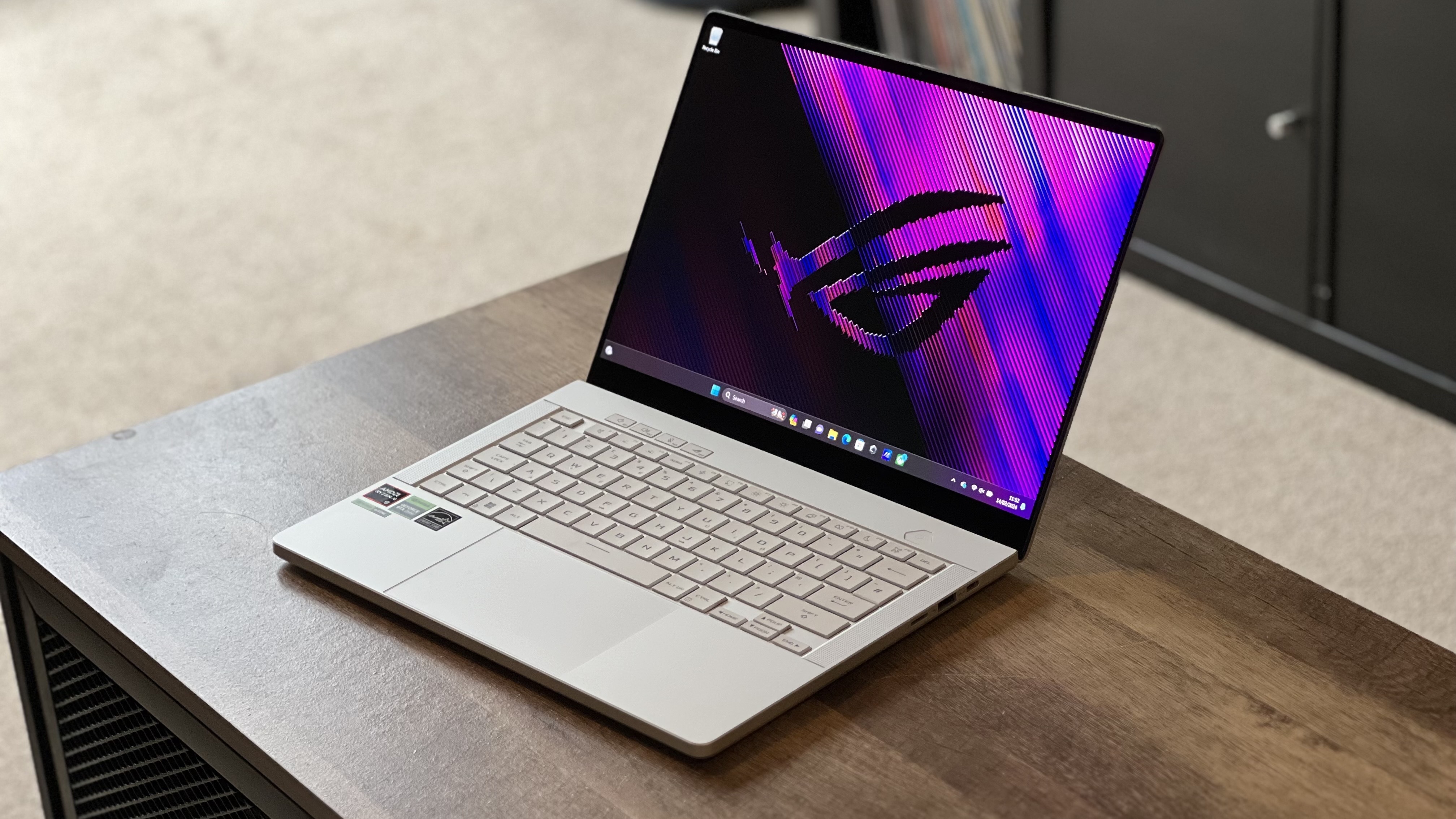
I was worried about the 2024 Asus ROG Zephyrus G14. Change is scary and this is one of my favorite gaming laptops of all time. I've had my hands on every release since 2019 in one way or another, and loved every second I could spend with these miniature powerhouses. A complete redesign, the sacrifice of RTX 4080 and RTX 4090 options, a whole new screen type - these are all announcements that had me anxiously clutching my pearls during CES. After two weeks with the latest Asus ROG Zephyrus G14 in hand, though, and those updates have won me over. Mini LED who? This is where the G14 truly earns its spot among the best gaming laptops on the market.
Design
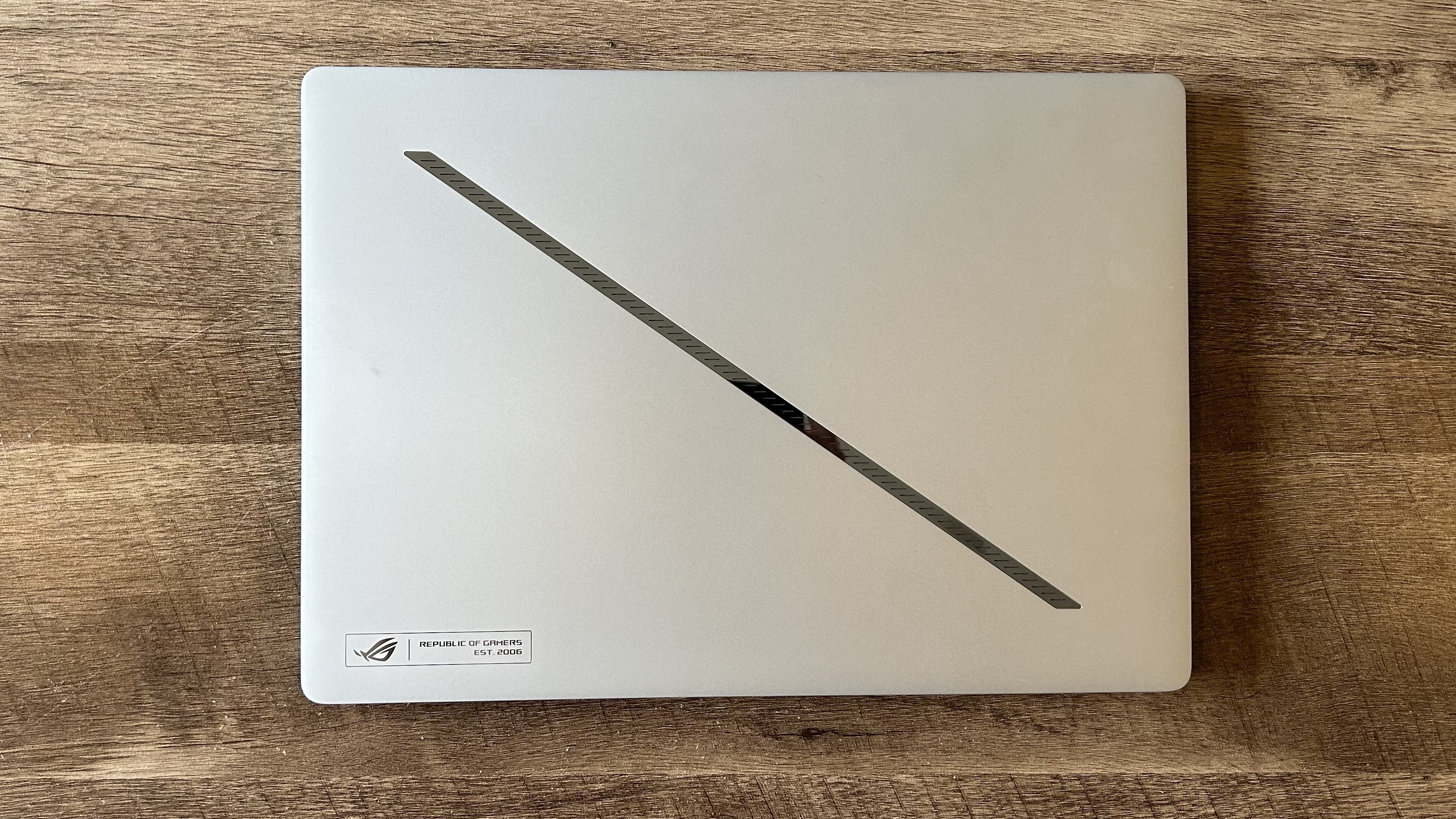
The biggest change to the Asus ROG Zephyrus G14 comes in its physical design. This is a much slimmer model, dropping the chunkier base plate required for heavier RTX 4080 and RTX 4090 graphics cards and adopting a more mainstream ultralight profile. It's by no means as skinny as some of the more high profile non-gaming options out there (a creative market Asus is looking to tap with this new release), but it still feels impossible as a gaming device. Other gaming laptops have been taking aim at this infinitely more portable form factor in recent years, but the current roster can't beat the G14's 1.5kg. The Razer Blade 14 clocks in at 1.8kg and last year's G14 packs a 1.7kg footprint - even the Alienware x14 R2 comes in at 1.9kg.
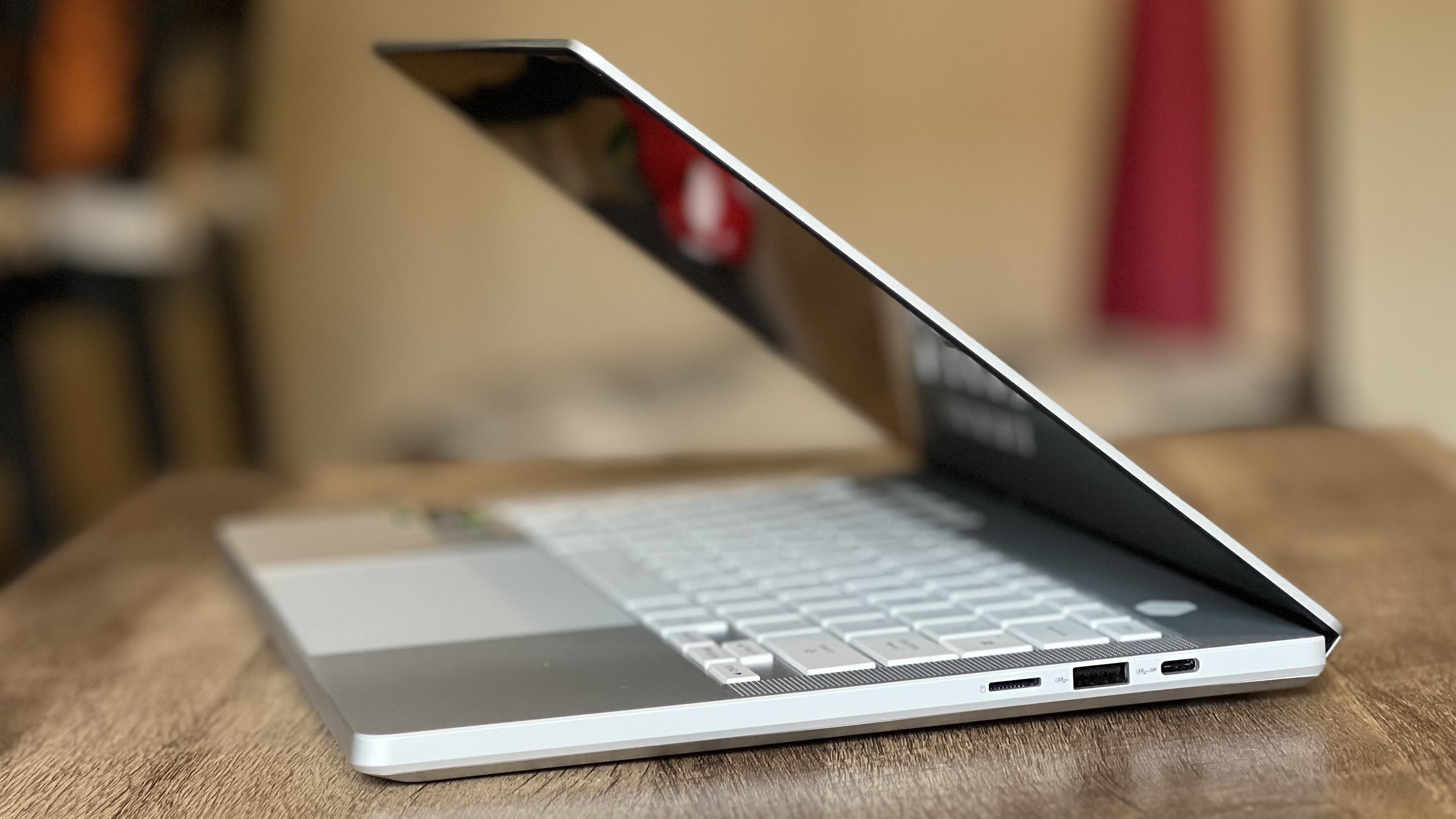
It's obvious, though, that Asus is taking the Zephyrus G14 beyond its gaming roots. The dotted LED matrix display of yore has been replaced by a super slick diagonal stripe running along the back of the lid. This is a glossy glass by itself, but can be illuminated with 28 mini LEDs for added flair. That more restrained aesthetic, combined with the unibody CNC milled aluminum chassis, gives the G14 a strong MacBook feel. I was initially confusing the G14 with my own MacBook Pro when simply carrying the device around, due to the soft-touch light silver finish and flat square design - even the rounded corners feel like a Tim Cook touch.
That luxury feel extends to the build quality as well. Try as I might I was unable to flex the main baseplate, and while there's a little flexibility to the lid it's one of the sturdier screens I've tested. The whole clamshell is comfortably opened with one hand, with a smooth hinge designed to keep hot air away from the display itself. That does mean sacrificing the drop hinge I loved on the previous model, in favor of a more unified design - with no rise to the keyboard either.
Features
Asus has also changed the G14's feature set inside and out, swapping out the Nebula Mini LED display for a Samsung designed OLED panel and scaling back its configuration options.
Last year's Mini LED was certainly impressive, but it felt like a step backwards from the same tech's implementation in larger Asus gaming laptops. The OLED panel available here is a revelation. The incredible contrast and super fast response times are married perfectly with a bolstered '3K' (2880 x 1800) resolution to produce an incredibly vivid picture overall. Everything jumps off the screen here - forget the dappled sunlight and vivid green hues of Assassin's Creed: Odyssey or the almost alien glow of Cyberpunk 2077, I was impressed just watching developer logos splashing across the screen on boot.
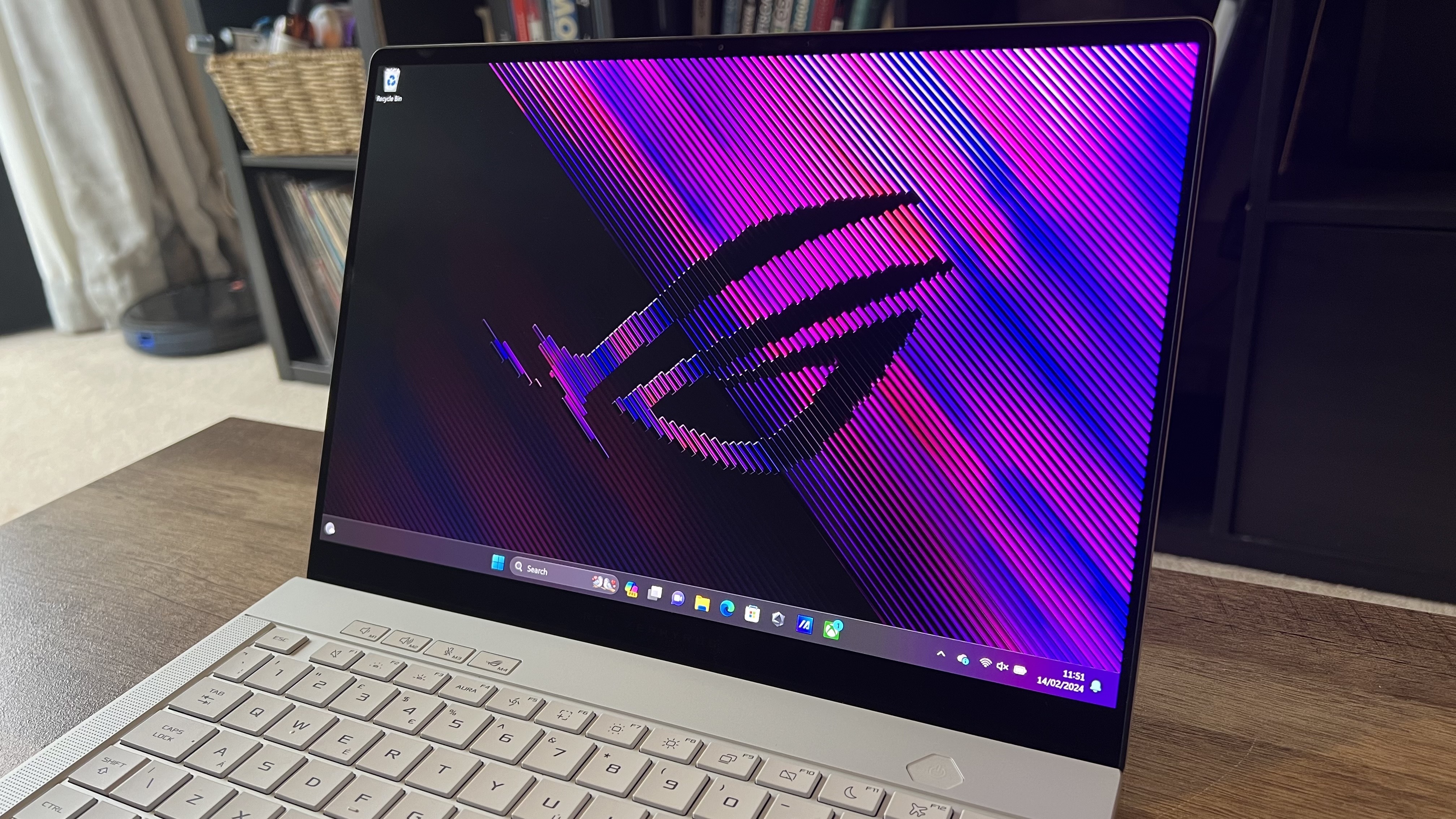
The Nebula part of Asus's marketing relates to its HDR system which is alright - Windows 11 isn't currently handling HDR content by itself particularly well and with the lowered overall brightness of an OLED panel adding further fuel it's not the panel's main selling point. Still, the fantastic contrast you are getting here is well worth the trade off if you're both a gamer and creator.
Under the hood, you'll find an AMD Ryzen 9 8945HS processor across all models, with either an RTX 4050, RTX 4060 or RTX 4070 GPU at the helm. That CPU is more of an iterative upgrade over the previous generation that doesn't push the newer release too much further than last year. However, if you're after the full power of the RTX 4080 and RTX 4090 it's worth noting that the 2023 Asus ROG Zephyrus G14 is still available in these higher configurations.
As we'll see in the performance section, though, those premium GPUs might not be worth the trade. The OLED screen on here is incredibly well implemented - and could be reason by itself to stick with an RTX 4070 configuration. Those chasing the highest possible framerates will have to stick to 2023's offerings, but the power on offer here is more than enough for everyday play and after the last two weeks I can definitively say I would rather have the boosted screen. DLSS 3 is also your saving grace here.
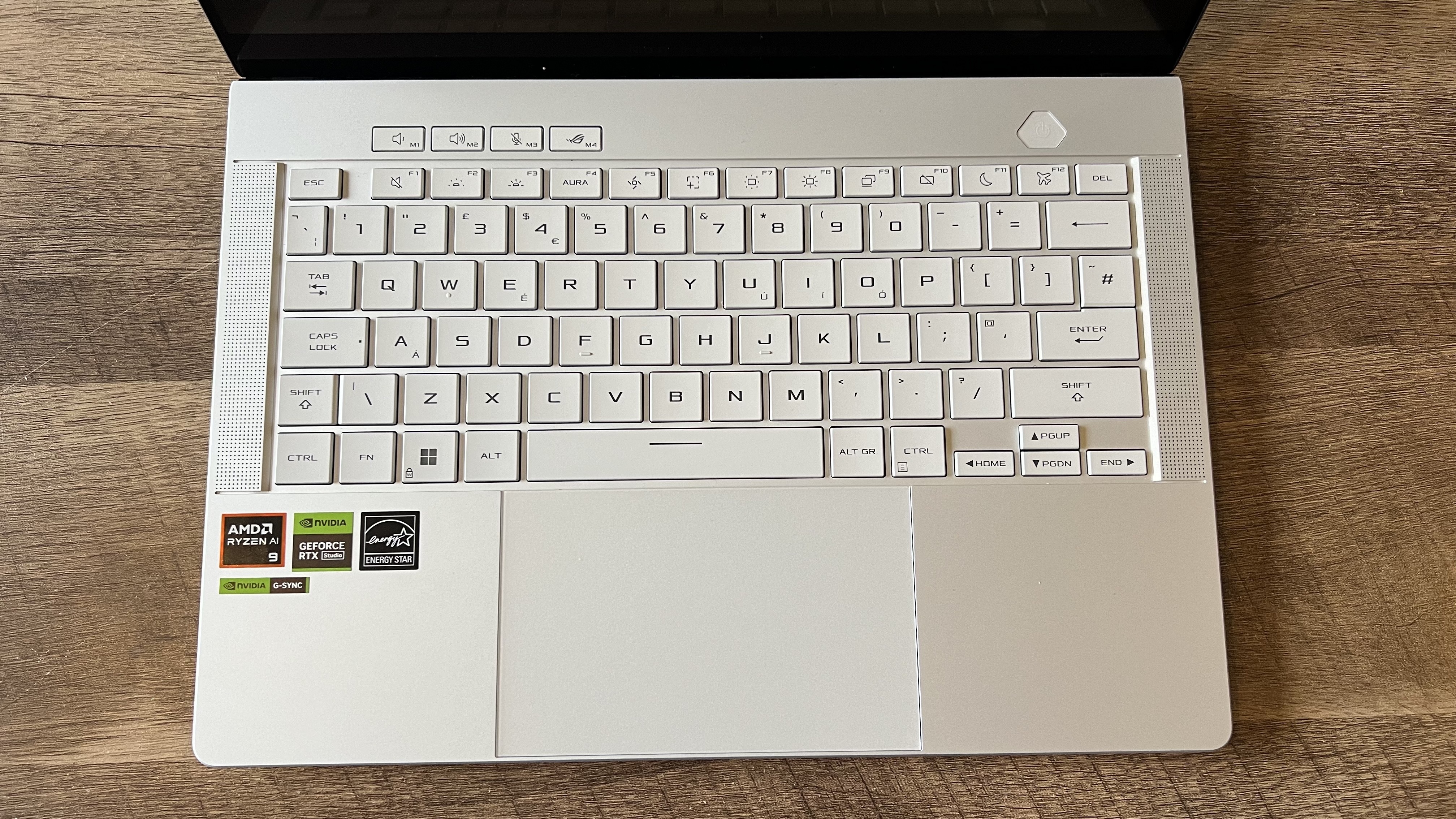
The keyboard feels super slick under the hand, with generously sized keycaps... for the main part. The arrow keys are halved, making them a little difficult to hit in more frantic gameplay situations. Sill, there's a good amount of space around the left and right arrows so I was able to find them without having to scan. Each key actuates with a soft but satisfying clack and a tactile feel while skimming over the top - they're also covered with a particularly pleasing smooth finish. You've got everything you need here as well, though there's no dedicated macro for switching between performance modes like you'll see on larger rigs.
On top of all that the 2024 Asus ROG Zephyrus G14 still doesn't compromise on its ports. Everything but Thunderbolt 4 is catered for here (due to the AMD build), with plenty of options on both sides of the rig for additional flexibility.
Performance
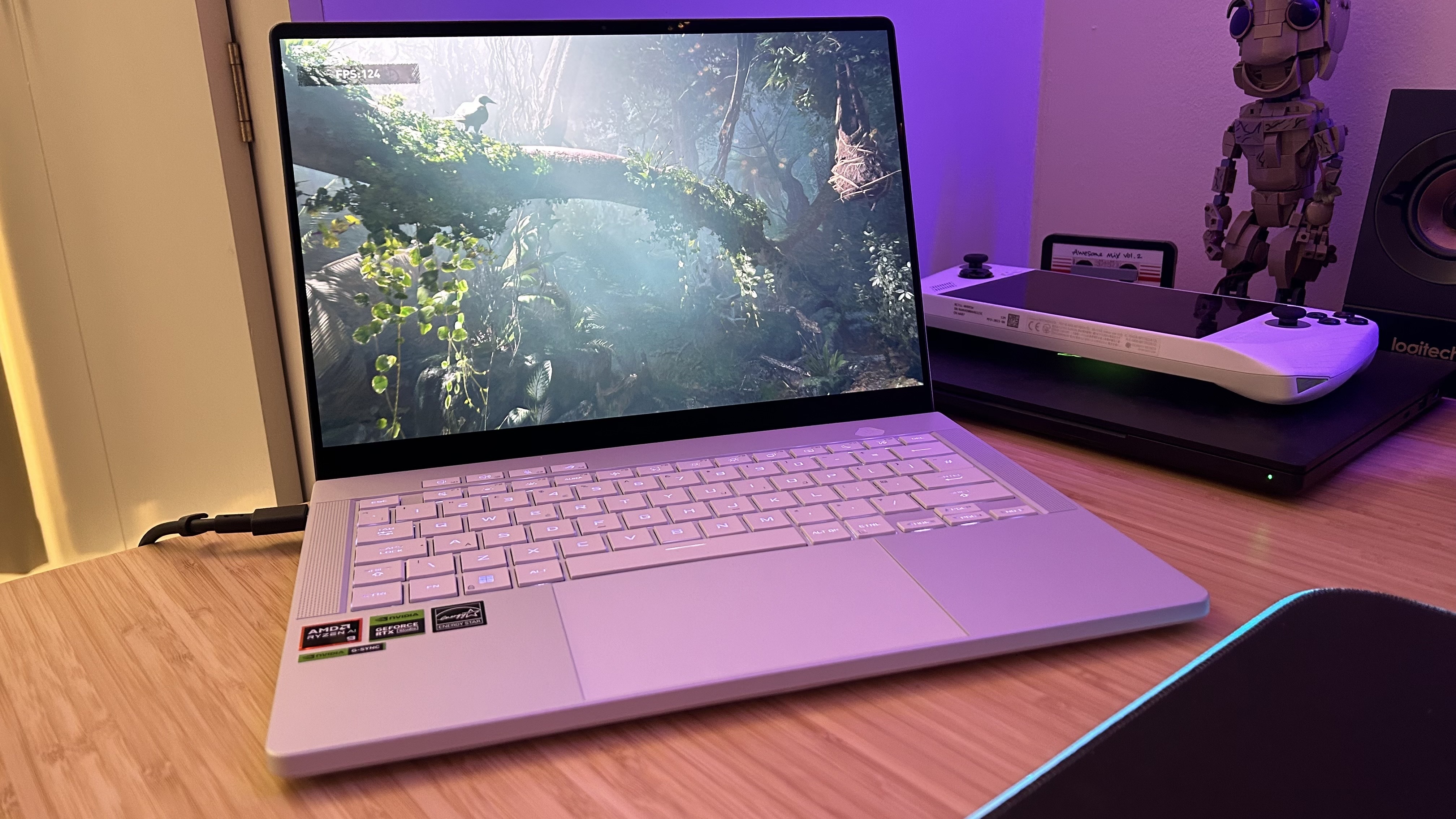
Time Spy | 10,624
Fire Strike | 24,378
Cinebench 2024 | Multi: 882 | Single: 102
PC Mark 10 | 7,697
My test unit was running an RTX 4070 GPU, so it naturally won't be competing on the same level as the RTX 4090 previous generation I tested last year. Still, three figure framerates were fully on the table here - and they certainly shouldn't be taken for granted. After all, this is a slimline gaming laptop housing power that would have been unthinkable just a few years ago. I've included my results from last year's G14 as a reference for those costing up the drop from an RTX 4090 GPU.
Overall performance puts the 2024 Asus ROG Zephyrus G14 on par with last year's Razer Blade 14 - sometimes edging ahead and sometimes nudging behind. Both of our test machines in this match up were running RTX 4070 GPUs, though the Blade 14 switches the CPU out for an AMD Ryzen 9 7940HS. Given the minor upgrades to this year's chip, though, that shouldn't pose too much of a difference.
It's also worth noting that Cinebench 2024 results sit on a different scale to the previous Cinebench R23 benchmarks we have completed on other models.
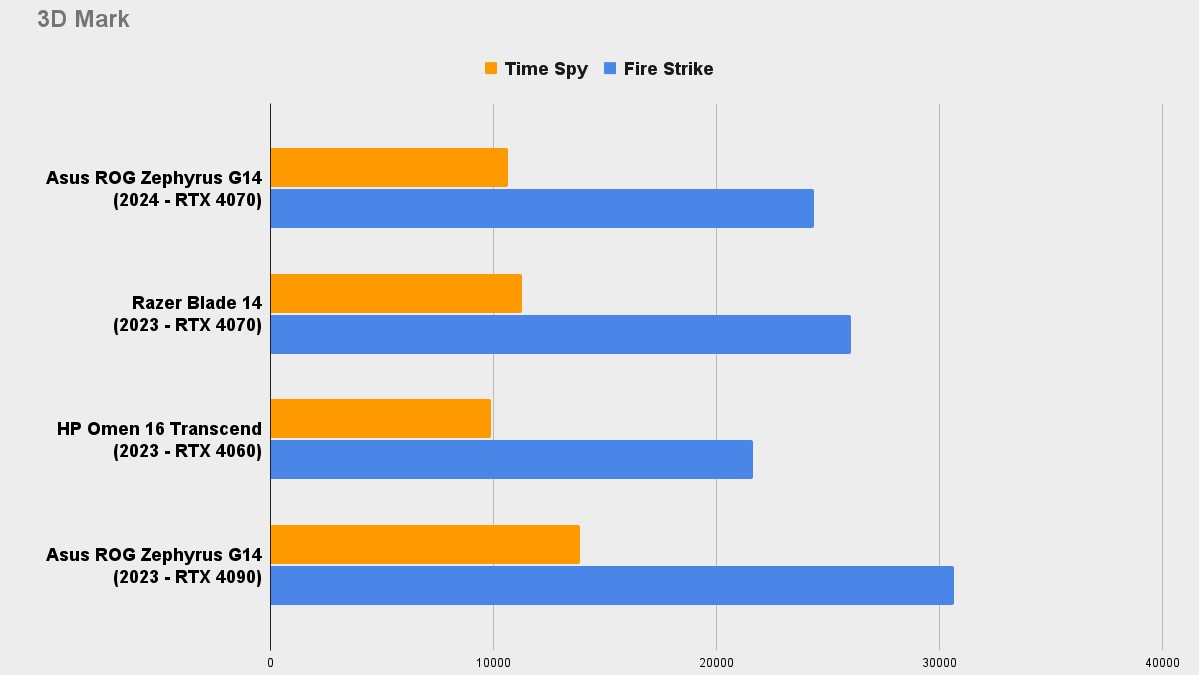
Performance mode 3D Mark benchmarks put the Asus ROG Zephyrus G14 behind the Razer Blade 14 in raw performance, with a 5% decrease in results between the two devices. Bumping things into the system's Turbo mode for the machine's full 90W power potential, those numbers took a healthy jump. I averaged an 11,531 score in Time Spy and 25,952 for Fire Strike with those fans running at full power.
In-game the Asus ROG Zephyrus G14 put on an excellent show. While there are some symptoms of that skinny chassis design in some top-end QHD+ results, these are more than playable framerates from even particularly demanding titles. I've seen far lower numbers in chunky (but considerably cheaper) gaming laptops running the same RTX 4070 graphics cards, so being able to pull of this kind of reliable performance in a miniature chassis is certainly impressive.
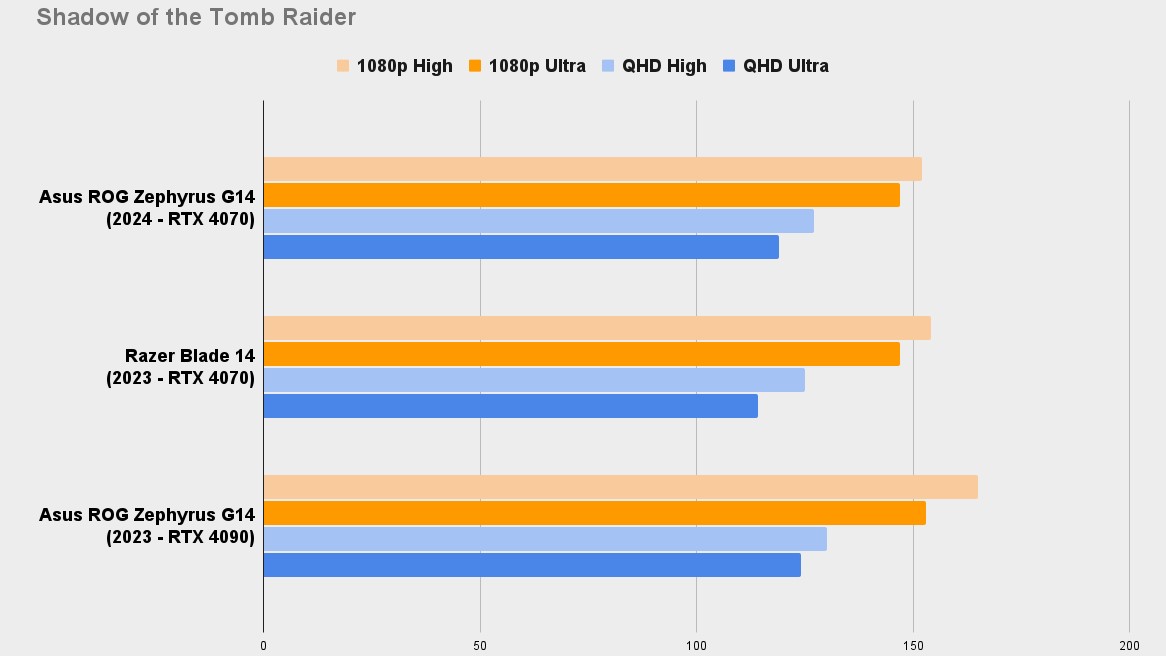
The Asus ROG Zephyrus G14 does drop behind the Blade 14 ever so slightly in 1080p on Shadow of the Tomb Raider's benchmark, however it starts to pull away from it in a QHD+ setting. The increased native resolution of the display is, obviously, taking its effect here and even though those gains are small (a jump of around 4%) they still keep the Zeph competitive.
The drop down to an RTX 4070 doesn't cut quite so deep here either. Last year's test unit was pulling 165fps in 1080p at High settings, and 124fps at QHD Highest - not a million miles away from today's 152fps / 119fps in the same categories. At these heights, that's far from a sacrifice.
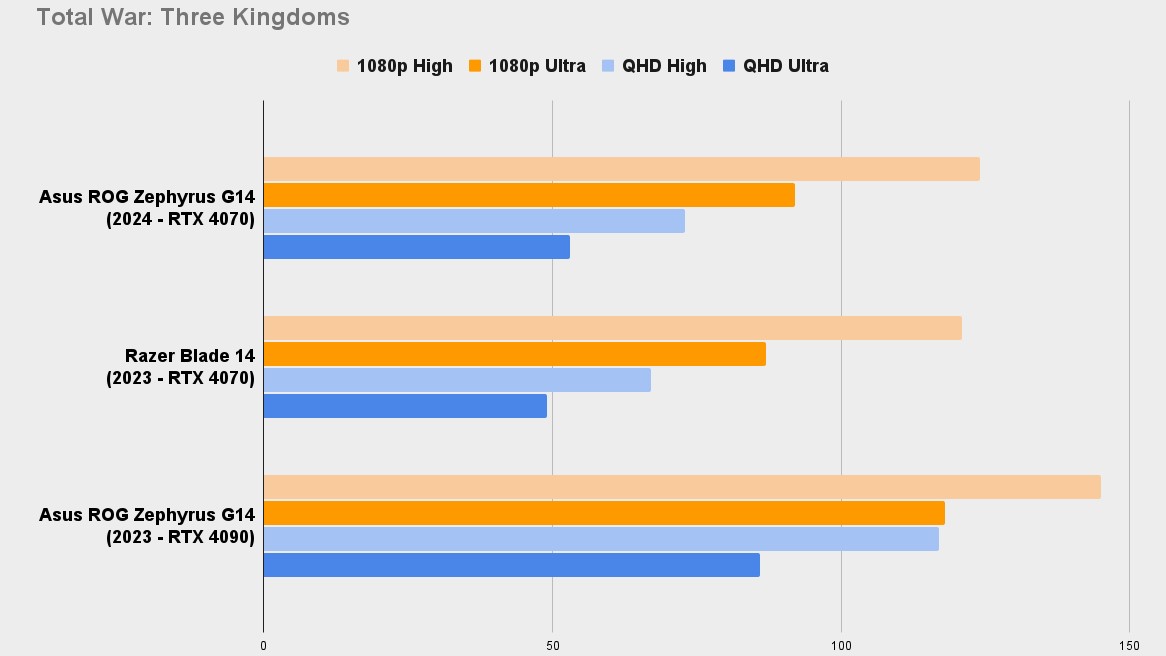
Three Kingdoms' Battle benchmark often poses gaming laptops a slightly higher threat, with massive scenes rendering an abundance of tiny little warriors and all the special effects they command. Here, though the Zephyrus G14 held out well, beating the Razer Blade 14 across both FHD and QHD+ resolutions. That RTX 4090 comparison is a little starker with this slightly more chaotic task, though. Ultra QHD+ framerates took a plunge, kicking the 2024 model to sub-60fps levels while the 2023 version sails through at 86fps.
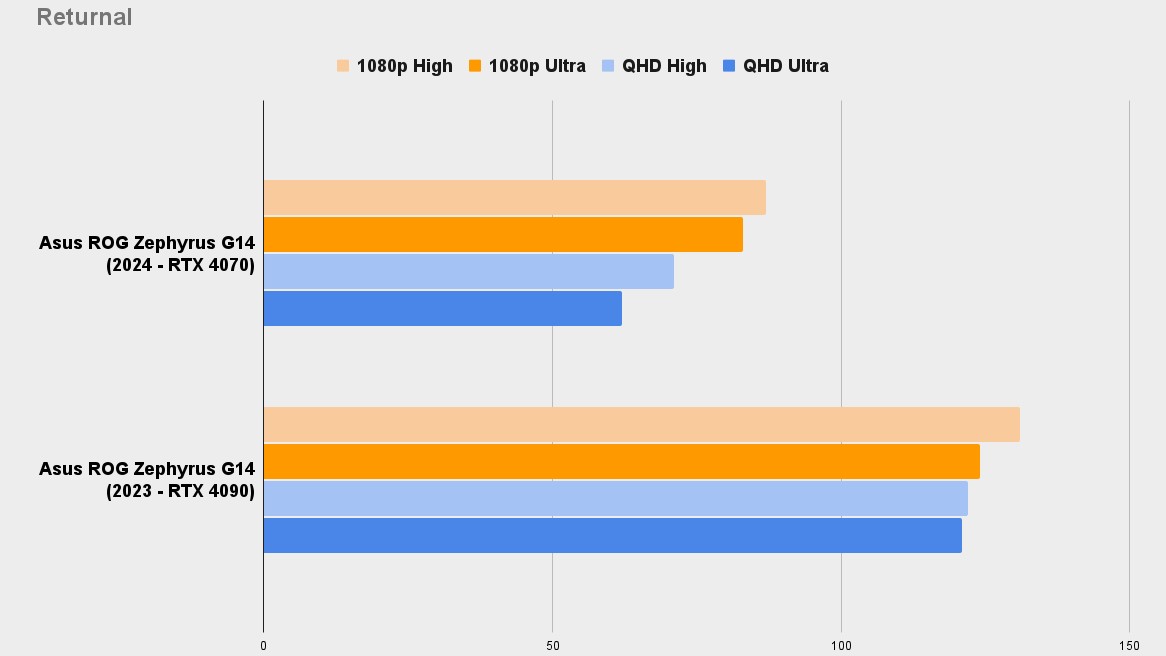
This is a heavy one. Returnal is still a demanding game for a slimline gaming laptop, and these numbers prove it. While this benchmark wasn't part of our testing suite when the Razer Blade 14 was on the desk last year, it was a part of the 2023 Zephyrus G14's dissection. Those differences between the RTX 4070 and RTX 4090 of the two generations are going to be obvious - but the fact that we're still comfortably over 60fps here is still well worth shouting about.
It's an indication of things to come, though. The 2024 G14's performance is holding on by today's standards, but with heavier games on the way these components might not offer enough to stand the test of time in a few years.
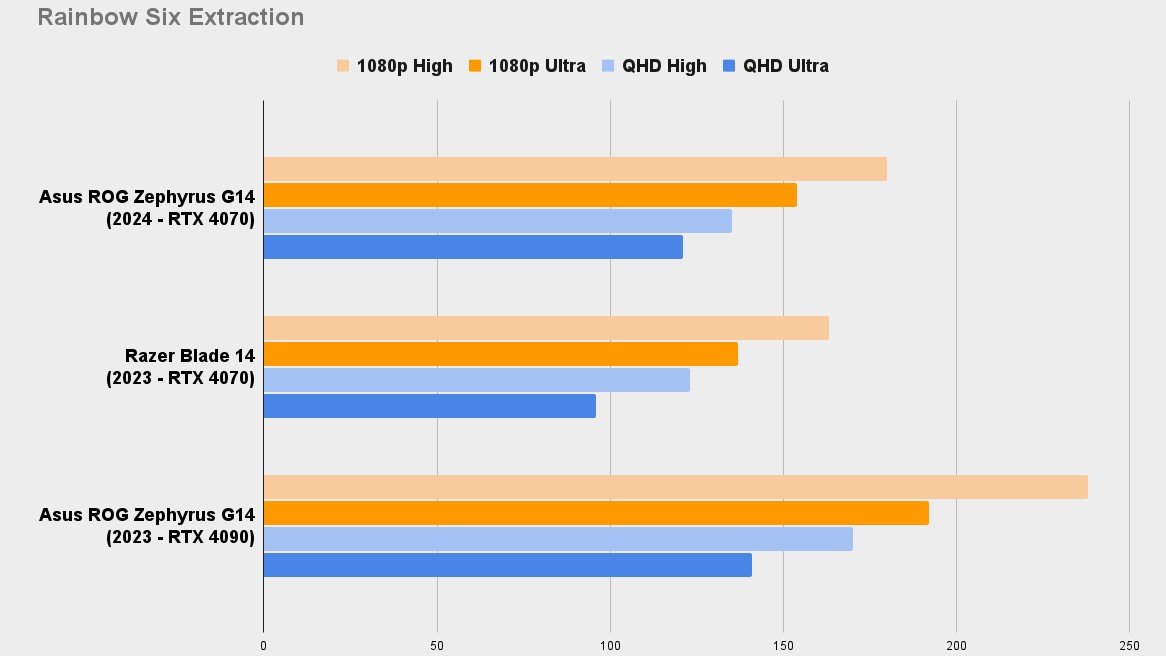
Rainbow Six Extraction is a naturally faster game that doesn't put as much pressure on a system's GPU, and the G14 benefitted massively from this rest. The FPS style allowed it to jump back up to nearly 200fps in 1080p, and still comfortable sit well over 100fps even in Ultra QHD+ settings. That's well ahead of the Razer Blade 14 which doesn't quite rev its engines so well when given an open road like this.
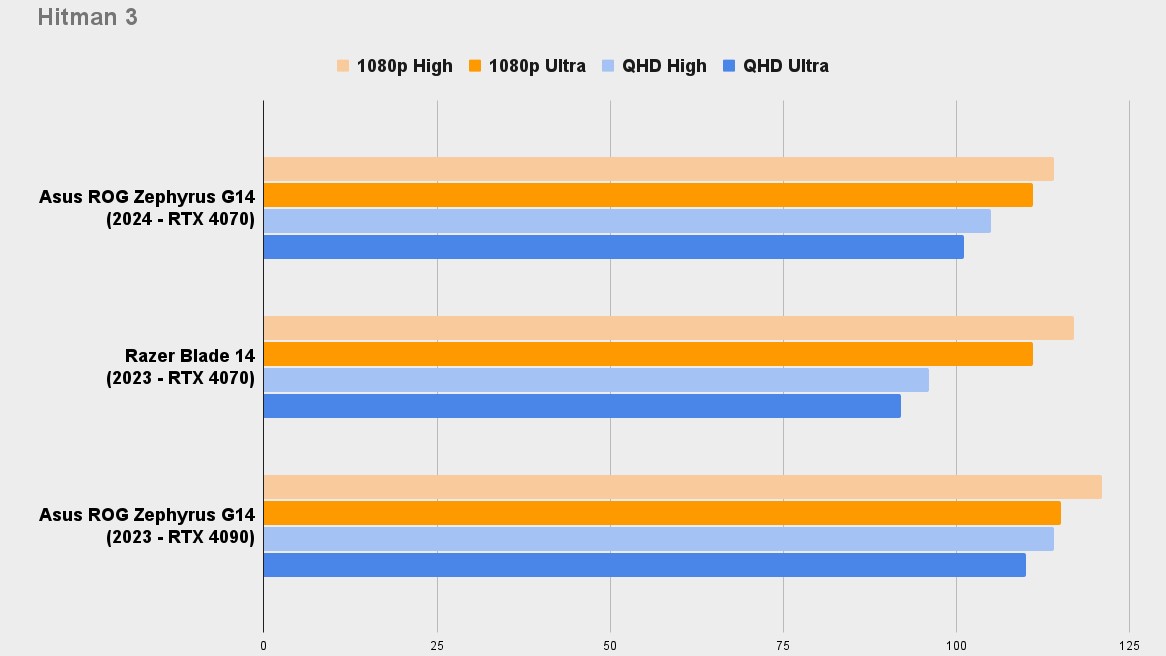
Hitman 3's benchmark gave us a far more clustered result. The 2024 Asus ROG Zephyrus G14 was much closer to its predecessor's performance here, only tailing by a few frames in each test. While 1080p performance lagged ever so slightly behind the Razer Blade, QHD+ numbers were once again pulling ahead.
Should you buy the 2024 Asus ROG Zephyrus G14?
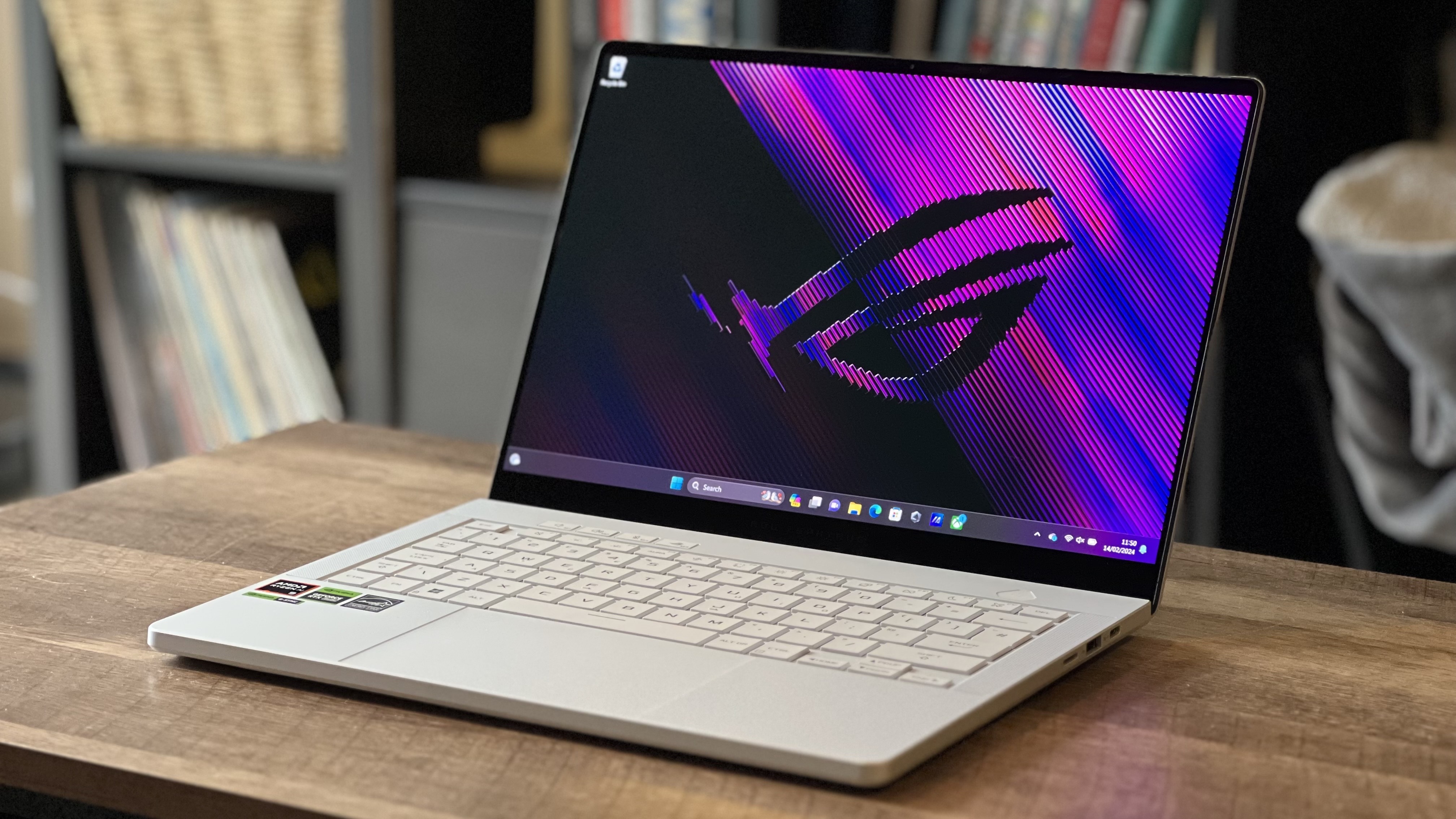
I can't remember the last time I told someone looking for a 14-inch gaming laptop not to buy an Asus ROG Zephyrus G14. This year is no different, but my recommendation comes with a slight caveat. If you're chasing framerates and you'll be playing the latest and greatest games at ultra settings for years to come, it's worth considering the older 2023 model. You're still getting a super portable device but as my testing has showed, more demanding titles do put that RTX 4090 GPU on show.
There's a big but here, though. I don't think the vast majority of players out there would benefit more from taking a step backwards like this. The RTX 4070 inside 2024's Asus ROG Zephyrus G14 is more than capable of seeing you through today's games (and likely the games to come in the next couple of years) comfortably. If you're not pushing max settings, or if you're happy to rely on DLSS features, even more so.
The overall aesthetic, lightweight footprint, luxury form factor, and astonishing display more than make up for the 20-or-so frames per second you're dropping with the new model. Considering you'll barely notice that dip in performance when we're talking about 100+ framerates, it's an easy trade to make.
Asus is coming for Razer's lunch here - taking aim at both the gaming and creator markets with one luxury swoop. Compared to the Razer Blade 14, the Asus ROG Zephyrus G14 has another trick up its sleeve. It's considerably cheaper than the luxury Razer device that pretty much performed on par with the G14 in my testing. If you're going to be solely playing in 1080p that edge in lower resolution framerates could sway you towards the green snake if you have the budget, but the display and QHD+ performance would always bring me right back to Asus.
How we tested the Asus ROG Zephyrus G14
I used the Asus ROG Zephyrus G14 for two weeks alongside the testing of the Asus ROG Strix Scar 18 and the Acer Nitro 16. In that time I tested across everyday play in Assassin's Creed: Odyssey, Cyberpunk 2077, and House Flipper while also benchmark testing in Shadow of the Tomb Raider, Total War: Three Kingdoms, Returnal, Rainbow Six Extraction, Hitman 3, and industry tests from 3D Mark, PC Mark 10, and Cinebench. For more information on how we test gaming laptops, check out the full GamesRadar+ Hardware Policy.
If you're between brands, you can also check out the best Razer laptops and the best Alienware laptops on the market right now - or take a look at the best gaming PCs for something more permanent.







